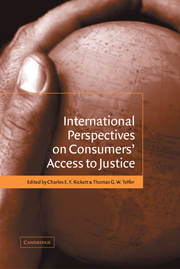Book contents
- Frontmatter
- Contents
- List of contributors
- Preface
- Table of cases
- Table of statutes
- 1 Consumers' access to justice: an introduction
- Part I Perspectives on consumers' access to justice
- Part II Issues in contract and tort
- Part III Services and the consumer
- Part IV Consumer bankruptcy law
- 10 Access to the discharge in Canadian bankruptcy law and the new role of surplus income: a historical perspective
- 11 The death of consumer bankruptcy in the United States
- Part V Procedure and process issues
- Part VI Conflict of laws issues
- Index
11 - The death of consumer bankruptcy in the United States
from Part IV - Consumer bankruptcy law
Published online by Cambridge University Press: 11 July 2009
- Frontmatter
- Contents
- List of contributors
- Preface
- Table of cases
- Table of statutes
- 1 Consumers' access to justice: an introduction
- Part I Perspectives on consumers' access to justice
- Part II Issues in contract and tort
- Part III Services and the consumer
- Part IV Consumer bankruptcy law
- 10 Access to the discharge in Canadian bankruptcy law and the new role of surplus income: a historical perspective
- 11 The death of consumer bankruptcy in the United States
- Part V Procedure and process issues
- Part VI Conflict of laws issues
- Index
Summary
Introduction
Consumer bankruptcy in the United States as it has existed for over a century narrowly escaped death in the year 2000. But that venerable institution is on death row; only the execution date remains to be set. The 106th Congress passed a major bankruptcy ‘reform’ bill in December 2000. The fundamental purpose of the Reform Bill is to deny many consumer debtors an immediate discharge of their debts in a Chapter 7 liquidation bankruptcy,leaving only the Hobson's choice of forgoing bankruptcy relief altogether or attempting to ‘repay their creditors the maximum that they can afford’ in a Chapter 13 repayment plan. Only a pocket veto of the Reform Bill by then-President William Clinton on 19 December 2000 granted a temporary reprieve.
The salvation of consumer bankruptcy may be short-lived. If possible, the fate of traditional consumer bankruptcy has been hanging by an even more precarious thread in the 107th Congress than ever before. In March 2001, both chambers overwhelmingly passed slightly different versions of a bankruptcy reform bill. President George W. Bush has made it known that he supports the bankruptcy legislation and, unlike his predecessor, will sign a bankruptcy bill. All that apparently remained was for the House and the Senate to appoint conferees, reach a compromise in conference regarding the handful of differences in the two chambers' passed bills, and present the conference version to the willing President for signature.
- Type
- Chapter
- Information
- International Perspectives on Consumers' Access to Justice , pp. 264 - 300Publisher: Cambridge University PressPrint publication year: 2003
- 1
- Cited by



